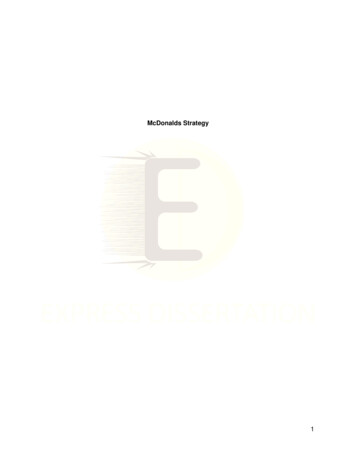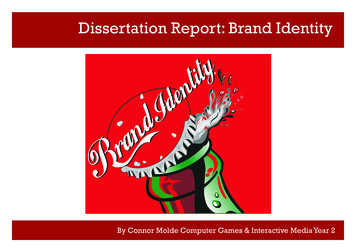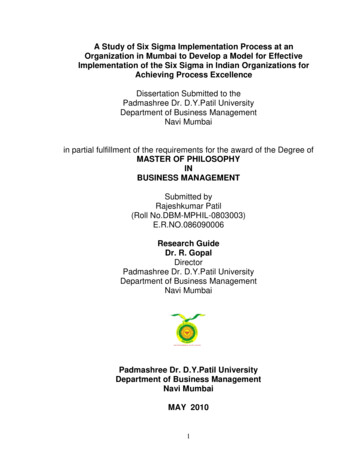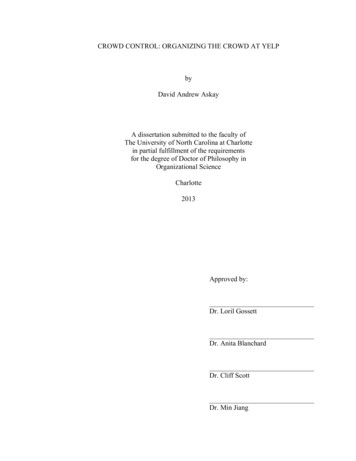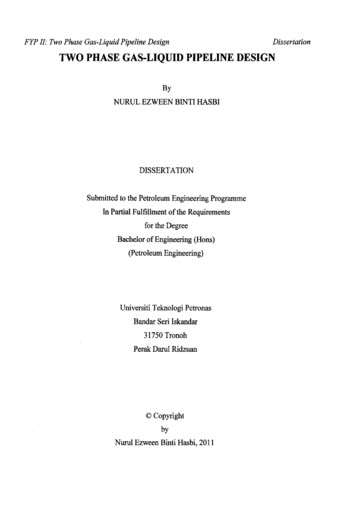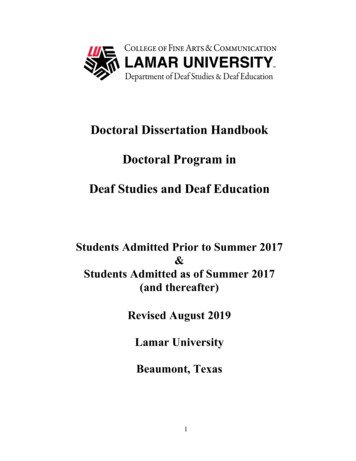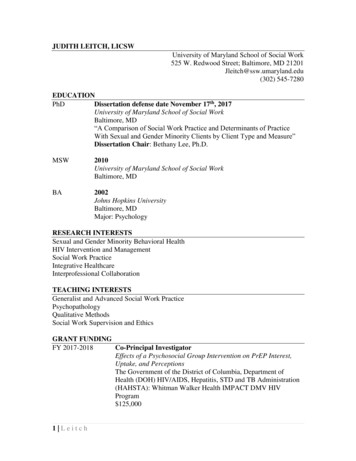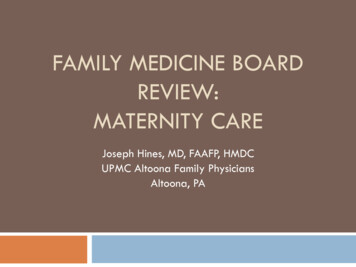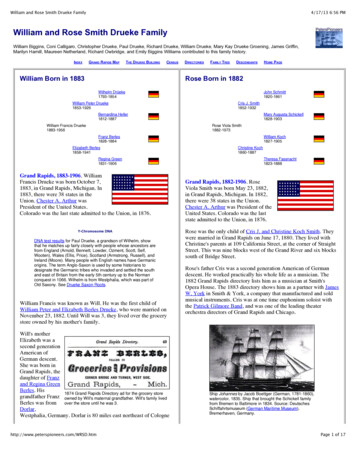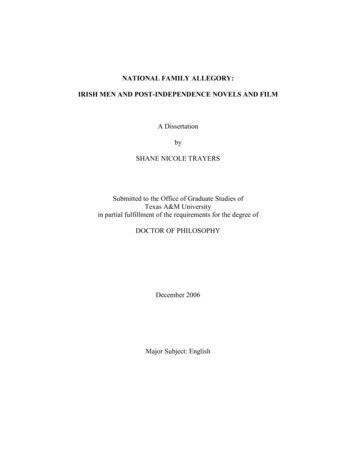
Transcription
NATIONAL FAMILY ALLEGORY:IRISH MEN AND POST-INDEPENDENCE NOVELS AND FILMA DissertationbySHANE NICOLE TRAYERSSubmitted to the Office of Graduate Studies ofTexas A&M Universityin partial fulfillment of the requirements for the degree ofDOCTOR OF PHILOSOPHYDecember 2006Major Subject: English
NATIONAL FAMILY ALLEGORY:IRISH MEN AND POST-INDEPENDENCE NOVELS AND FILMA DissertationbySHANE NICOLE TRAYERSSubmitted to the Office of Graduate Studies ofTexas A&M Universityin partial fulfillment of the requirements for the degree ofDOCTOR OF PHILOSOPHYApproved by:Chair of Committee, Marian EideCommittee Members, Cynthia BoutonKatherine E. KellySally RobinsonHead of Department, Paul A. ParrishDecember 2006Major Subject: English
iiiABSTRACTNational Family Allegory: Irish Men andPost-Independence Novels and Film. (December 2006)Shane Nicole Trayers, B.A., Muhlenberg College;M.A., American UniversityChair of Advisory Committee: Dr. Marian EideThis dissertation explores the ideological functions of the National FamilyAllegory in post-Independence novels and film created by male authors and filmdirectors. Ideology functions as a lingering force in service of the status quo, the currentpower structure, and these works recreate the same family structures as those establishedduring colonization and through national myth. The roles of Mother Ireland, savior sons,and failing fathers repeat, sometimes through creative means. Although the texts attemptto subvert the allegory, many post-Independence works eventually show the traditionaland conservative family structure of the National Family Allegory.The first chapter, “Importantly Motherless: Spontaneous Child Creation and MaleMaternity,” analyzes the connection between the missing Mother figure and malefantasies of pregnancy and child creation. Because of the lack of stable family structure,usually connected to early childhood abandonment or mistreatment, the novels discussedin this chapter show the absolute necessity of family in creating a personal and nationalidentity.In the second chapter, “’You Can’t Protect Your Women’”: Male Irish Terroristsas Protector in Popular American and Irish Films, 1984-1998,” the young man/son
ivprotagonist in his role as protector of the woman/Mother figure is analyzed in sixdifferent films.In the third chapter, “Articulation and Stasis: The Son as Haunted Echo of theFather in McCann’s Songdogs,” discusses the father and son dynamic in relation to themissing mother in this diasporic novel to indicate that the Irish National Family Allegoryholds true even during the dispersion of post-Famine Irish identity.The last chapter, “Failing Fathers,” examines the father figure in Roddy Doyle’s AStar Called Henry, Patrick McCabe’s The Butcher Boy, and John McGahern’s AmongstWomen. A father’s traditional role is to function in the public sphere and also to controlthe family, yet each of these father’s fail in their roles, which is typical of the NationalFamily Allegory role established within the literature.
vACKNOWLEDGEMENTSI would like to thank my committee chair, Dr. Marian Eide, and my committeemembers, Dr. Cynthia Bouton, Dr. Katherine Kelly, and Dr. Sally Robinson for all oftheir help and support throughout the many evolutions of this project.Additionally, thanks to my family for their patience, understanding, and supportthroughout the process. I would like to thank my colleagues in the Texas A&M EnglishDepartment for their guidance and lively discussions, particularly Rebecca Stout Fields,Tom Martin, Tracy Boyd, and Rebecca Caldwell. I want to extend my gratitude to myfriends for their love and continued understanding, especially Geoff Wyche and AndySon.
viTABLE OF CONTENTSPageABSTRACT iiiACKNOWLEDGEMENTS .vTABLE OF CONTENTS .viCHAPTERIINTRODUCTION . .1II“IMPORTANTLY MOTHERLESS”: SPONTANEOUSCHILD CREATION AND MALE MATERNITY 24IIIIVHistory of Male Maternity .“Five Years Old and Reading Pushkin”: Jake’s Response toFoster Care .“He’s Ours”:Pussy’s Dreams of Motherhood Madonna and Whore: Leopold Bloom’s Loss of Legacy .27323852“YOU CAN’T PROTECT YOUR WOMEN”: MALEIRISH PROTAGONISTS AS PROTECTOR IN POPULARAMERICAN AND IRISH FILMS, 1984-1998. 61Male Masochism and the Son Role .Son as Victim, Martyr, and Savior .American vs. Irish Depictions .The Jackal: Declam Mulqueen as Sacrificial Sharpshooter Blown Away: Liam’s Heroic Sacrifice A Prayer for the Dying: Martin as Religious Sacrifice .The Boxer: Danny as Peaceful Pugilist .The Crying Game: Fergus as Substitute Savior .Cal: Protagonist as Redeemed Sinner .6365717277838996109ARTICULATION AND STASIS: THE SON AS HAUNTEDECHO OF THE FATHER IN MCCANN’S SONGDOGS .118Articulation .Stasis Death and Photography .Doubling and the Cyclical Life .Juanita: The Center of the Circle .The Objects of Michael’s Photographs 121133134138145147
viiCHAPTERPagePhotographs as Evidence and Conor’s Oedipal Response . .Conclusion .158163FAILING FATHERS AND COPY-CAT SONS: THEMYTHIC FICTIONS OF THE PATERNAL ROLE .165Michael Moran: A Legacy of Verbal and Physical Abuse .The Pig and the Priest: A Legacy of Violence Intensified .Henry as Father and Son: A Legacy of Murder for Hire .Henry the Son as Father .170179193200CONCLUSION .212Irish Catholic White Masculinity Areas for Further Research .Summation .214216218WORKS CITED.219VITA 228VVI
1CHAPTER IINTRODUCTIONArticle 41 of the Constitution of Ireland states:1.1 The State recognizes the Family as the natural primary and fundamental unit group ofSociety, and as a moral institution possessing inalienable and imprescriptible rights,antecedent and superior to all positive law.1.2 The State, therefore, guarantees to protect the Family in its constitution and authority,as the necessary basis of social order and as indispensable to the welfare of the Nationand the State.As is evident by its inclusion in the Irish Constitution, the “Family” is an integral part ofboth Irish culture and politics to the point where it is defined as “primary,”“fundamental,” and indispensable” to the nation as a whole.1 The family is alsounderstood as a model for the nation in Ireland; As David Lloyd writes, “As in thefamily, so in the nation, as nationalist ideologists have so often stressed” (16).2 Althoughfamily is not defined within the Constitution itself, culturally it is understood to refer onlyto the heterosexual nuclear family. Other non-traditional family forms, homosexuality,and women’s rights are often viewed as a threat to this family unit (Conrad 4-5). Hence,there is an Irish cultural need to protect the idea of nuclear family from outside forces orThis dissertation follows the style and format of the MLA Style Manual.1The term “Family” refers to heterosexual, nuclear, traditional family roles as created by the Irish mythos.2Marilyn Cohen and Nancy J. Curtin make this same claim: “Feminists have long argued that the family orprivate domain is no less political than the public, and further the private has been aggressively colonizedby the public in Ireland. Familist ideology is, after all, as many of our contributors remind us, enshrined inArticle 41 of the Constitution” (5).
2threats; this struggle emerges, both are portrayed as nearly equivalent within the contextof contemporary culture, and this is reflected through its repeated centrality in literatureand film.When I first began this dissertation project, I truly expected to find that postIndependence novels and film would demonstrate the development of new Irishmasculine identities that functioned as a subversion of the gender norms, particularlythose established during British colonization.3 It is typical of victims of Imperial policyto subvert cultural gender norms, so it would stand to reason that Irish post-Independencetexts would follow this pattern.4 This was my initial assumption.However, due to my interest in the effects of Irish National discourse on Irishmasculinity, I limited my scope in this project solely to works by male authors and maledirectors, while maintaining a feminist perspective and method. What I found byexamining this set of texts described in this dissertation – along with many others thatfollow the pattern but which are not included here -- surprised me. The works of maleauthors and film directors demonstrate a desire for subversive behaviors and newpossibilities for identity in a newly independent nation. But this desire is consistentlytrumped by the magnetic pull of conservative Irish cultural ideological norms. Theresulting texts present a constant negotiation between the desire for change and theseduction of familiar roles.3“Subversion” here refers to the action of utilizing concealed or disguised means to overthrow, disturb,break up, upset or undermine.4Homi Bhabha discusses this in “Signs Taken for Wonders.”
3I came to understand this negotiation through the neo-Marxist concept of ideology.Literary texts symbolically demonstrate and recreate the ideological conflict. Rather thanthinking of these texts as representations of the Irish condition, however, I began torecognize them as participants in a broad cultural discourse on gender in Ireland.As much as these works by men want to break out of the conventional depictions thatprescribe the traditional gender roles, it is, at the same time, advantageous for men toperpetuate an ideology from which they gain a measure of power and through which theymaintain the status quo. The traditional family roles, created during colonization anddeveloped during rebellion and after Independence into the National Family Allegory, areconstantly subverted and then finally supported symbolically within the same texts.Ideology functions as a lingering force in service of the status quo, the current powerstructure. This is not to be seen as behaviorism. As Louis Althusser widely andrepeatedly stated, “Ideology has no history.” According to Althusser and others,ideology is not a form of determinism and does not function as a particular event butinstead is a constant process of negotiation. It is a never ending process that limitssubversion by a constant return to that which benefits the power structure.Allegory functions as the means of production for the ideological force in relation toIrish culture. Allegory is a rhetorical tool, which functions to allow for the negotiationbetween subversive and static representations of personal and national identity. Allegoryis also multi-functioning, especially in post-Independence Irish texts. For example, thesame character type can represent several forces in power simultaneously throughconflation. For example, the “son” role in contemporary Irish literature can be a religious
4figure (Christ-like martyr) or a symbol of rebellion (in response to rhetoric by Pearse andothers) at the same time. Ideology does not limit what the allegory represents. Instead, itcan allow for negotiation of different power structures simultaneously through culturalconflation.This “Irish National Family” mythos has been embedded in Irish culture throughcenturies of representations and cultural pressures and is greatly influenced by theallegories present in the language of colonization, and so it is not unexpected that manyartistic works incorporate the family structure through allegory as a way to represent thenation. As Frederic Jameson contends:All third-world texts are necessarily, I want to argue, allegorical, and in a veryspecific way: they are to be read as what I will call national allegories, even when, orperhaps I should say, particularly when their forms develop out of predominantlywestern machineries of representation, such as the novel .Third-world texts, eventhose which are seemingly private and invested with a properly libidinal dynamic –necessarily project a political dimension in the form of national allegory: the story ofthe private individual destiny is always an allegory of the embattled situation of thepublic third-world culture and society (69) 5Much contemporary Irish literature and film, particularly those created by male authorsand directors, follow this same pattern. Whenever the focus of the work is a privatefamily world, it not only represents a personal conflict but a very public one5Several critics have chastised Jameson for his use of the term, “Third World,” which is certainly outdatedand potentially offensive. In the context of his wider body of criticism, the term might be understood to beequivalent to the later, more broadly adopted concept of the postcolonial. Indeed, Jameson himself appliedthe concepts outlined in this essay to his study of Irish literature as postcolonial literature in the essay,“Modernism and Imperialism” found in Nationalism, Colonialism and Literature.
5simultaneously. As Kathryn Conrad states, “The difference between Ireland and theUnited States is that in Ireland the conflation of home, family, and nation is explicit;private and public are rhetorically intertwined in the Irish Constitution” (65). Not onlyare the works allegorical, but as I will argue, they follow a particular pattern thatincorporates influences from colonial rhetoric, religious symbolism, and revolutionarymovements to establish very specific roles for each different member of the family, andwriters negotiate their representations within the context of these roles.This dissertation argues that while some contemporary Irish literature subvertstraditional family roles, most of them show a more conservative pattern within Irishliterature.6 Most contemporary Irish novels and film demonstrate the same systems ofrepresentation that began even before Cathleen ni Houlihan, but which the play solidifiedinto culture. 7 The model of the Irish family prescribes roles within the Irish nationalmyth that tells the story of a savior son protecting and sacrificing himself for the motherand the nation, the Mother Ireland (often conflated with the Virgin Mary) acting ascatalyst for male martyrdom, and a controlling father as a patriarch. Ironically, theliterature itself shows that for all the struggle to define Irishness, these same texts havecreated a stasis in representation. Even as the real world progresses forward, Irelandenjoys general political stability, economic improvement, and marked changes in familylife, gender roles, and the place of religion in public and private culture. Nevertheless,post-Independence literature shows a need for traditional family and indicates how the6In particular, I will be examining works created by male authors and male directors, which seem to utilizethe National Family Allegory on a regular basis.7The play by Yeats performed in 1902.
6destruction of those very family expectations have affected personal and nationalidentity.8 In other words, while there may be new identities forming in this rapidlychanging nation, most national literature -- in spite of its aesthetic innovations and itsattempts to produce subversive identity possibilities -- is nonetheless caught in a staticposition representing and reproducing the same Irish National Family. Althoughcontemporary works often construct (on the surface at least) the most non-traditionalfamily structures -- often with missing parents or families torn apart by illness, death, orwar – insidiously, these same works use substitution or fantasy to reconstitute thetraditional family, reestablishing the National Family Allegory’s psychic and socialpower in each successive repetition.These object figures do not have to be biological, and most often, they are not relatedto the masculine protagonist. In fact, the substitute mother figures, for example, whichare the most prevalent of substitutions, can be from a different nationality, race, or evengender, but the role itself is played out according to the same rules. Even if thesesubstitutions do not hold up within the text or if the substitution is created only in fantasy,the fact that they are present to make up for a family absence shows a very obsessiveconcern with preserving the traditional roles.Ireland, a colony of Britain from the reign of Elizabeth I, only gained Independencefor the South in 1922; hence Ireland has only been an independent country for less thanone hundred years, a relatively short time period in terms of the development of cultural8Although James Joyce’s Ulysses , first published in 1922, the year of independence, was written beforethe original treaty that allowed for self-governance for the South of Ireland, the patterns in it reflect thesame Family structures of the contemporary works. I have included it within the dissertation due to the factthat it is an important and central text for the development of Irish literature.
7identity. Literature, as a reflection of and force upon culture, shows a struggle to dealwith the labels and mythology of the colonized past, and it would be easy to understandthat authors and filmmakers would likely attempt to reject the family roles placed onthem through the colonization process. These contemporary Irish authors and filmmakersare often considered revolutionary in their depictions and their subject matter, and theirworks tackle such social and political topics as terrorism, sexuality and gender roles,transvestism, and family violence. However, as I will show, contemporary Irish novelsand film’s attempts at subversion fail under the weight of creative repetition of existingideologies. These works rehearse but do not reject familial roles upon which nationalidentity is based. The way in which these works repeatedly and subconsciously fit thecharacters of even the most dysfunctional or rebellious of families into this sameallegory, these same family roles, shows a greater ideological investment, a represseddesire for cultural stability, that these roles are believed to fulfill. While many of thefictions of independent Ireland present themselves as subversive of colonial ideology,many narratives in fact conform to the patriarchal and hierarchical patterns of theimperial period. The republican values of the turn-of-the-century revolution somewhatcollapsed before the greater ideological power of the Catholic Church and thepatriarchical family.99Kevin Whelan explains that revisionist theory believes that “neither human agency nor unjust social andpolitical systems should be held accountable,” specially for the Famine, but by extension as the onlyinfluences on Irish culture (205).
8Slavoj Zizek outlines a similar dynamic in The Sublime Object of Ideology, in whichhe argues that ideology functions not only as a misrepresentation of the real but alsoserves to construct that very misrepresentation as reality:[Ideology] is a matter of a discordance between what people are effectively doingand what they think they are doing – ideology consists in the very fact that thepeople ‘do not know what they are really doing,’ that they have a falserepresentation of social reality to which they belong (the distortion produced, ofcourse, by the same reality) (31)Yet, not only does ideology create a misrepresented reality, but that very constructionmasks the need it is created to fulfill:Ideology is not a dreamlike illusion that we build to escape insupportable reality;in its basic dimension it is a fantasy-construction, which serves as a support forour ‘reality’ itself: an ‘illusion’ which structures our effective, real socialrelations and thereby masks some insupportable, real, impossible kernel (Zizek45)Family roles fulfill an ideologically normative function. Many contemporary Irish textsunwittingly support the idea that the nuclear family structure, so “fundamental” in theConstitution, is necessary to the very function of Irish society. By implication, thesewriters suggest that ideologically, without the family, the cultural, social and politicalstructure will collapse. The repeated inclusion of characters that fit the National FamilyAllegory demonstrates the desire for the stability, for political, social and gender stasis(impossible in reality) that is conservative rather than revolutionary.
9Utilizing Jameson’s critical theories on postcolonial allegory and Zizek’s ideas aboutideology, I will be reading the Irish National Family Allegory within selected postIndependence Irish texts and films. These representations were solidified duringcolonization and function ideologically. Simultaneously, this dissertation is concernedprimarily with examining the masculine roles within the National Family Allegory, sincemuch has been written on Mother Ireland and other female roles within Irish literatureand film, but there is a paucity of analysis of Irish masculinity within these structures.The following chapters will apply the concept of male masochism to the savior sonstructure, particularly in reference to son roles.10The dissertation will combine all of these major areas, the National Family Allegory,ideology, and major theories of masculinity, in order to create a new area of research andfoundation for greater analysis of contemporary Irish texts. Within the plethora ofcontemporary Irish novels and film, my focus is on novels and film of this periodprimarily written by men. Another dissertation might be written to pose the question ofwhether the collaborative processes of dramatic performance produce an alternativeFamily Allegory or if novels and film with female protagonists and representations bywomen change these established roles.Before discussing the origins of and influences on these roles throughout the Irishcolonial period, it is important to note that although the focus of my analysis is on theconstructions of masculinity within the family structure, I argue that this masculinity isrelational to the prevalent figure of the Mother as nation; masculine roles emerge from10I will be utilizing several major critical theorists in the area of masculinity, including Tania Modleski,Carol Siegel, Sally Robinson and others.
10this dominant, though powerless figure. A son’s role, for example, is to free the motherthrough revolutionary action, while the father’s role is traditionally to control andstabilize the Mother/Nation/Family. Because of this pattern, a mother’s role is integral inunderstanding Irish masculinity in contemporary cultural work, and masculine roles areconstituted in relation to her.11Even early national mythology depicted Ireland as female, even to the extent that theland itself was represented as a female body, but the depiction was always of thepowerlessness of the feminine (Lewes 103). She was to be acted upon and never hadagency until the mother role later evolved through the solidification that came fromcolonization and Christianity.At least by the seventeenth century and possibly before, the British Empire reflectedin its colonizing rhetoric ideas of what Darby Lewes calls “somatopia,” which essentiallyis an extended metaphor comparing foreign lands with the bodies of women:When seventeenth-century British explorers loaded their ships, they packed thesomatopic metaphor along with the grog and sea biscuit. The genre enableddaring seamen and conservative landsmen alike to regard the new lands and theirindigenous populations as feminized territories whose destiny was to beconquered, cultivated and exploited by Europeans. Virgin lands were, after all,like virgin women – ripe and eager to be plucked and savored (103)Although Lewes does not specifically discuss the repercussions of this type of colonialrationalization on the Irish people, this idea applies to all of the territories of Britain’s11Condren discusses this in The Serpent and the Goddess: Women, Religion, and Power in Celtic Ireland,examined in greater detail later.
11colonial empire.12 This type of thinking lead to the metaphorical idea of the “Rape” ofIreland by the masculinized British forces and the “indigenous population,” as well as thenation itself, whereby it took on a feminized (supposedly passive) subjugated positionthrough Britain’s colonizing penetration of Ireland.Although this colonial ideology paints Ireland as a “virgin” or wild, natural femalewaiting to be conquered, as all of the other foreign territories “needing” colonization, theIrish national female identity evolved over time from an enticing female to embodysimultaneously a distinctly “motherly” figure. Although there is no clear and undeniablecritical information as to how the mother figure as representative of nationhood evolvedfrom the ideas of a feminized country, there are some possible catalysts to the popularityof the symbol. One such source is a popular 1869 British children’s geography book thatLewes exhibits that actually shows a map of Ireland where the picture of a mothercarrying a child on her back is drawn over the Irish territories (144). This representationis, of course, British and although comic in nature, it does continue the colonialrationalizing propaganda through the visual depiction of Ireland as a feminine Motherfigure needing Britain’s subjugation for her own protection.13This dualistic symbol became internalized within Irish culture and then representedin nationalist Irish literary works beginning in the eighteenth century with the romantic12The concept of “somatopia” is not limited to Ireland. Ecofeminist critics, such as the works contained inEcofeminism edited by Karen J. Warren discuss the ways in which women’s bodies and the land areequated internationally.13Examining another possible catalyst, Margaret Kelleher’s Feminization of the Famine discusses this typeof feminine figure as shaped by British colonial rhetoric during the time of the Famine.
12poets and the aisling tradition.14 The most popular of these representations can be foundlater in William Butler Yeats's Cathleen ni Houlihan, performed in 1902.15 In this play,an old, haggard woman figure convinces young men to fight and die for her, which, bythe end, transforms her into a beautiful, young woman or perhaps a “Queen”. Attemptingto convince one of the young men to fight, the Old Woman tells him: “If anyone wouldgive me help he must give me himself, he must give me all” (Yeats 8). From this earlynationalist drama an ideological motif is perpetuated that suggests it is only the sacrificeof the men, the sons of Ireland, which enables the redemption of the country. Not only isthis a blending of the “virgin,” young woman and the “old mother” symbols but also itincludes the idea of the son who must sacrifice himself to save his mother or in greaternationalistic terms, his mother country16. As Condren states in The Serpent and theGoddess: Women, Religion, and Power in Celtic Ireland, “For the sake of the mother orthe ‘motherland’ one can feel justified for developing elaborate strategies of ‘defense’ orgoing to extreme heroic length for her sake, thereby mystifying the true social oreconomic issues at stake” (208).17 The fact that the mother(land) must be defended fromoutside forces places the woman in a position of power only through her helplessness.14Marian Eide discusses this in “The Woman of Ballyhoura Hills: James Joyce and the Politics ofCreativity”.15The play may have been co-written by Lady Gregory and William Butler Yeats.16An older and similar figure is that of “Roisin Dubh,” often translated as “Dark Rosaleen” or “BlackRose.” James Clarence Mangan created the most famous translation of a poem, immortalizing this figure.Within the poem, the speaker is willing to give up his life because Rosaleen can “give [him] life and soulanew/ A second life, a soul anew” (Dubh Trust). Often Rosaleen, like Cathleen, is consideredrepresentative of Ireland itself, and her reference in a literary work, including Mangen’s poem, can easilybe interpreted as a nationalistic symbol. Rosaleen was most likely also influential in and conflated into thecreation of the Mother Ireland representations.17Mary Condren’s The Serpent and the Goddess traces the figures of Eve, Brigit, and Mary and theirevolution and impact to feminism during early Irish/Christian symbolism. In particular, Condren explainshow Mary’s rise to a major figure within the church as a role model for women impacted their power statuswithin society and constricted their sexuality
13She can influence men to fight for her, but she cannot fight for herself. For threecenturies, she acts more as a symbol than as an agent in nationalist literature.This same sacrificial rhetoric acted as a catalyst for male masochism. It can be foundin speeches and writings from the Easter 1916 Republican Uprising and slightly before,especially in the discourse created by Padraig Pearse, a leader of the independencemovement. According to Susan Kingsley Kent’s analysis of the uprising’s drivingphilosophy, the purpose of the revolt was not to win freedom for Ireland, since thoseinvolved knew that this goal was an impossibility with so little manpower and such largeenemy resources, but instead, to sacrifice themselves in order to “resurrect a manlyIreland” through martyrdom:Pearse had never expected to defeat the British army. Their goalshad been more modest: to ignite, by means of a blood sacrifice on the part of Irishmanhood, nationalistic feeling throughout the country; to redeem through anassertion of heroic manliness the old hag that was Ireland, in the imagery ofWilliam Butler Yeats’s Cathleen ni Houlihan, and turn her back into a beautifulyoung queen by shedding their blood for her Pearse’s own writings hadcontinued the themes of degradation and redemption through a blood sa
in partial fulfillment of the requirements for the degree of DOCTOR OF PHILOSOPHY December 2006 Major Subject: English . NATIONAL FAMILY ALLEGORY: IRISH MEN AND POST-INDEPENDENCE NOVELS AND FILM A Dissertation by SHANE NICO
